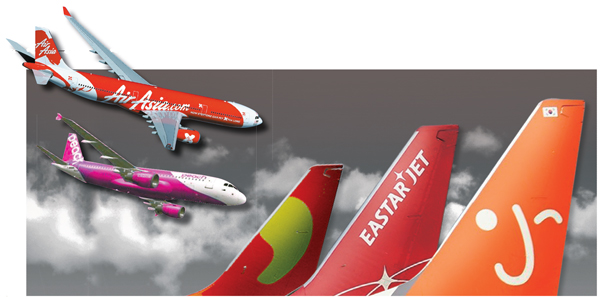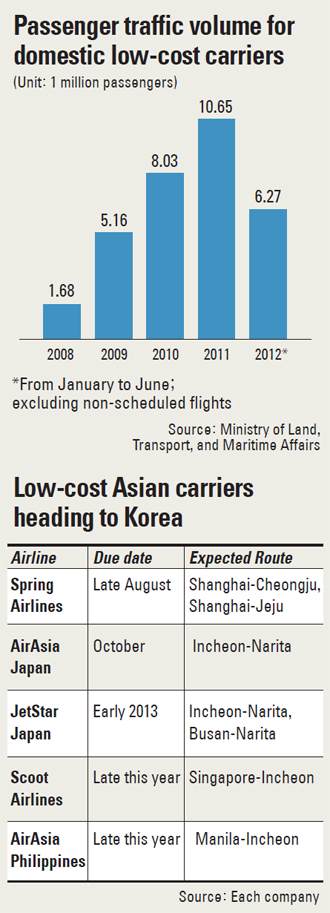Boom days may be over for local LCCs

The competition between domestic and foreign low-cost carriers is heating up as more international low-budget airlines are considering entering the local market with aggressive marketing plans in the second half of this year.
According to industry sources, four to five additional foreign low-cost carriers (LCCs) are scheduled to operate in Korean airspace no later than this year, while the budget foreign players already operating here plan to expand their businesses with new routes and enhanced customer services.
Korea recently emerged as an attractive market for international LCCs, particularly for Asia-based airlines, as the Korean Wave continues to garner worldwide attention, and Korea is seeing healthy growth in outbound travel.
With this trend, the LCC market has been growing rapidly and local budget airlines have been seeing their businesses boom.
In the first six months of the year, more than 6.27 million people used local LCCs, up 30.6 percent from the same period last year, according to the Ministry of Land, Transportation and Maritime Affairs. The number of people using LCCs to travel outside Korea jumped 112.4 percent on-year, reaching 1.54 million people. Local LCCs’ share of international routes also surged to 6.8 percent in the first half, almost double that of one year earlier. The ministry said this reflects how domestic budget carriers have been ramping up their interest in more lucrative international flights.
Currently, five local LCCs operate a total of 40 international routes. Jeju Air has 13, followed by Jin Air (11), Air Busan (8), Eastar Jet (5) and T’way Airlines (3). All span relatively short distances, linking to China, Japan or South East Asian nations.
More than 10 foreign LCCs fly routes from their respective countries to and from Korea. While carriers like Hong Kong’s Dragon Air and Philippine’s Cebu Pacific Air have been doing businesses in Korea for long time, Peach Aviation, Japan’s first LCC, recently joined the fray by operating flights from Osaka to Incheon in May. Japan’s StarFlyer followed suit last month by setting up Kitakyushu-Busan flights.

AirAsia, the largest low-fare, no-frills airlines in the region, has a presence in Korea through its subsidiary, AirAsia X, a long-haul budget carrier, in Korea. But these routes will not overlap with those to be used by the Japanese unit, it said. The company added that it is considering having its local unit in the Philippines also fly to Korea in the near future.
As a brand, AirAsia has already gained attention from local customers thanks to Korean football star Park Ji-sung, who moved from Manchester United to Queens Park Rangers, the club owned by AirAsia CEO Tony Fernandes.
The airline is expected to lean more on Park’s name and image to boost its marketing. It has already launched a special promotion giving away discounted tickets, in recognition of Park signing with the club.
China’s Spring Airlines is also expected to be a major player in the second half. China’s first and largest low-budget airline is notorious for its cheap tickets, which are about 30 percent lower than standard LCC prices. The airline is expected to open a route between Cheongju, North Chungcheong, and Shanghai, as well as Jeju and Shanghai, by early next month.
Singapore’s Scoot Airlines and Jetstar Japan, a joint venture between Qantas Airways, Japan Airlines and Mitsubishi Corporation, are also getting in line to carry Korean passengers late this year.
Local budget airlines are rolling out various marketing plans this summer to defend their turf.
Jin Air, an affiliate of the nation’s largest carrier, Korean Air, has adopted a mileage system in the second half called “Butterfly Points,” with rewards including free boarding passes for local flights. Air Busan also strengthened its “Fly & Fun” promotion after forming an alliance with Spa Valley, offering discounted entrance fees to the spa for those with boarding passes.
Eastar Jet launched an event with car-sharing company SoCar in Jeju, offering fliers free car rentals for up to 24 hours. Meanwhile, Jeju Air has been promoting its image by using idol group Big Bang as its front model to allure K-pop fans around the peninsula.
However, industry experts said that as market heats up, local LCCs might lose sight of urgently needed tasks, such as trimming unnecessary costs to lower prices and enhance customer service. Eastar and T’way are already reported to be in financial trouble, paving the way for cutthroat competition.
“I think we have too many LCCs considering our market size,” said one employee from a local airline. “As many foreign budget carriers are expected to join the market in the second half, already weak players will look especially vulnerable.”
To deal with unfavorable market conditions and rising costs, local budget airlines said yesterday they will increase domestic fares in the coming weeks.
Air Busan said it will raise its domestic fares by 9.7 percent on average from next month, while Eastar increased its fares by around 5 percent in July.
By Joo Kyung-don [kjoo@joongang.co.kr]










with the Korea JoongAng Daily
To write comments, please log in to one of the accounts.
Standards Board Policy (0/250자)